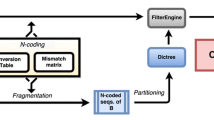Abstract
With the exploding size of genome databases, it is becoming increasingly important to devise search procedures that extract relevant information from them. One such procedure is particularly effective in finding new, distant members of a given family of related sequences: start with a multiple alignment of the given members of the family and use an integral or fractional consensus sequence derived from the alignment to further probe the database. However, the multiple alignment constructed to begin with may be biased due to skew in the sample of sequences used to construct it.
We suggest strategies to overcome the problem of bias in building consensus sequences. When the intention is to build a fractional consensus sequence (often termed a profile), we propose assigning weights to the sequences such that the resulting fractional sequence has roughly the same similarity score against each of the sequences in the family. We call such fractional consensus sequences balanced profiles. On the other hand, when only regular sequences can be used in the search, we propose that the consensus sequence have minimum maximum distance from any sequence in the family to avoid bias. Such sequences are NP-hard to compute exactly, so we present an approximation algorithm with very good performance ratio based on randomized rounding of an integer programming formulation of the problem. We also mention applications of the rounding method to selection of probes for disease detection and to construction of consensus maps.
Preview
Unable to display preview. Download preview PDF.
Similar content being viewed by others
References
Stephen F. Altschul, Raymond J. Carroll, and David J. Lipman. Weights for Data Related by a Tree. Journal of Molecular Biology, 207, 647–653, 1989.
A. Bairoch. Prosite: A Dictionary of Sites and patterns in Proteins. Nucleic Acids Research, 20, 2019–2022, 1992.
A. Bairoch, and B. Boeckmann. The SwissProt Protein Sequence Data Bank. Nucleic Acids Research, 20, 2019–2022, 1992.
M.O. Dayhoff, W.C. Barker and L.T. Hunt. Establishing homologies in protein sequences. Methods Enzymol., 91:524–545, 1983.
R. Dular, R. Kajioka, and S. Kasatiya. Comparison of gene-probe commercial kit and culture technique for the diagnosis of mycoplasma pneumoniae infection. J. of Clinical Microbiology, 26(5):1068–1069, May 1988.
S.R. Eddy, G. Mitchison, and R. Durbin. Maximum discrimination hidden Markov models of sequence consensus. J. of Computational Biology, 2:9–23. 1995.
M. Frances and A. Litman. On covering problems of codes. Technical Report 827, Technion, Israel, July 1994.
Program Manual for the Wisconsin Package, Version 8, September 1994, Genetics Computer Group, 575 Science Drive, Madison, Wisconsin, USA 53711.
M. Gribskov, A. D. McLachlan, and D. Eisenberg. Profile Analysis: Detection of Distantly Related Proteins. Proceedings of the National Academy of Science, U.S.A., 84, 4355–4358, 1987.
M. Gerstein, E. Sonnhammer, and C. Chothia. Volume Changes in protein evolution. J. Mol. Biol., 235:1067–1078, 1994.
Steven Henikoff and Jorja G. Henikoff. Position-based Sequence Weights. J. Mol. Biol., 243, 574–578, 1994.
W. Hoeffding. Probability inequalities for sums of bound random variables. J. Amer. Statist. Assoc., 58:13–30, 1963.
M. Ito, K. Shimizu, M. Nakanishi, and A. Hashimoto. Polynomial-time algorithms for computing characteristic strings. Proc. CPM 94, LNCS 807:274–288, 1994.
N. Karmarkar. A new polynomial time algorithm for linear programming, Combinatorica, 4:373–395, 1984.
A. Krogh, and G. Mitchison. Maximum entropy weighting of aligned sequences of protein or DNA, in Proc. Third Int. Conf. on Intelligent System for Mol. Biol., (C. Rawlings, D. Clark, R. Altman, L. Hunter, T. Lengauer, S. Wodak, eds.) pp. 215–221, AAAI Press, Menlo Park, CA, 1995.
R. Luthy, I. Xenarios, and P. Bicher. Improving the sensitivity of the sequence profile method, Protein Science, 3:139–146, 1994.
A.J.L. Macario and E.C.De. Macario. Gene Probes for Bacteria. Academic Press, 1990.
R. Motwani and P. Raghavan. Randomized Algorithms. Cambridge University Press, 1995.
P. Raghavan. A probabilistic construction of deterministic algorithms: Approximating packing integer programs. Journal of Computer and System Sciences, 37:130–143, 1988.
R. Ravi and J. D. Kececioglu. Approximation algorithms for multiple sequence alignment under a fixed evolutionary tree, Proc. CPM 95, LNCS 937:330–339, 1995.
P. Raghavan and C.D. Thompson. Randomized rounding: a technique for provably good algorithms and algorithmic proofs, Combinatorica, 7:365–374, 1987.
Peter R. Sibbald and Patrick Argos. Weighting Aligned Protein or Nucleic Acid Sequences to Correct for Unequal Representation. Journal of Molecular Biology, 216, 813–818, 1990.
T.F. Smith and M.S. Waterman. Comparison of Biosequences. Adv. Appl. Math., 482–489, 1981.
J.D. Thompson, D.G. Higgins and T.J. Gibson. Improved sensitivity of profile searches through the use of sequence weights and gap excision, Comput. Applic. Biosci., 10:19–29, 1994.
M. Vingron and P. Argos. A fast and sensitive multiple sequence alignment algorithm. Comput. Appl. Biosci., 5:115–121, 1989.
M. Vingron and P.R. Sibbald. Weighting in sequence space: A comparison of methods in terms of generalized sequences. Proc. Natl. Acad. Sci. USA, 90:8777–8781, 1993.
Author information
Authors and Affiliations
Editor information
Rights and permissions
Copyright information
© 1997 Springer-Verlag Berlin Heidelberg
About this paper
Cite this paper
Ben-Dor, A., Lancia, G., Ravi, R., Perone, J. (1997). Banishing bias from consensus sequences. In: Apostolico, A., Hein, J. (eds) Combinatorial Pattern Matching. CPM 1997. Lecture Notes in Computer Science, vol 1264. Springer, Berlin, Heidelberg. https://doi.org/10.1007/3-540-63220-4_63
Download citation
DOI: https://doi.org/10.1007/3-540-63220-4_63
Published:
Publisher Name: Springer, Berlin, Heidelberg
Print ISBN: 978-3-540-63220-7
Online ISBN: 978-3-540-69214-0
eBook Packages: Springer Book Archive




